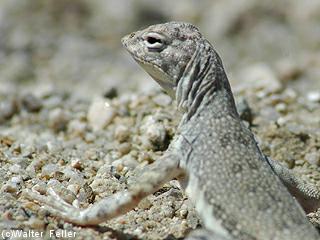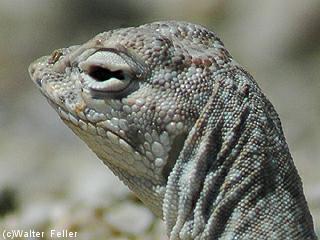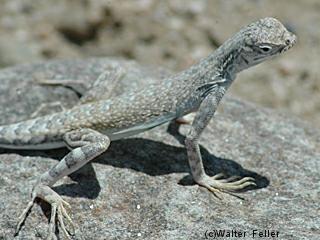Zebra-tailed Lizard

The Zebra-tailed Lizard (Callisaurus draconoides) is an intriguing species with several distinctive traits and behaviors. Here's a detailed look at its natural history:
Physical Description
Size:
Typically ranges from 2.5 to 4 inches in body length, with the tail often being longer than the body.Coloration:
Light gray to beige with dark crossbands on the body and a distinctive black and white striped tail. Males often have blue patches on their bellies during the breeding season.Habitat
Geographical Range:
Found in the southwestern United States and northern Mexico, including the Mojave and Sonoran deserts.Preferred Habitat:
Prefers open, sandy, or rocky areas with sparse vegetation. Often seen in washes, dunes, and flat, open desert terrain.Behavior
Locomotion:
Known for its remarkable speed and agility, the Zebra-tailed Lizard can run on its hind legs when threatened. This bipedal running helps it escape predators.Thermoregulation:
Like most desert lizards, it is ectothermic, basking in the sun to regulate its body temperature. During the hottest part of the day, it may seek shade or burrow to avoid overheating.Tail Display:
The striped tail is often raised and wiggled to distract predators or signal to other lizards.Diet
Diet:
Primarily insectivorous, feeding on ants, beetles, grasshoppers, and other small invertebrates. They may also consume plant material occasionally.Foraging Behavior:
Actively forages during the cooler parts of the day, usually early morning and late afternoon.Reproduction
Breeding Season:
Typically occurs in the spring and early summer.Nesting:
Females lay eggs in shallow burrows dug into the sand. A single clutch can contain 2 to 8 eggs, which hatch after an incubation period of about 60 to 80 days.Hatchlings:
Juvenile lizards are independent from birth and must fend for themselves immediately.Adaptations
Camouflage:
Their coloration and patterns help them blend into their sandy and rocky environments, providing camouflage from predators.Speed:
Their ability to run quickly, often on their hind legs, is a key survival adaptation.Conservation
Status:
Generally not considered at risk, but habitat destruction and environmental changes could impact local populations. Conservation efforts focus on preserving natural habitats and minimizing human disturbances.The Zebra-tailed Lizard is an excellent example of desert adaptation, showcasing how species evolve to thrive in harsh, arid environments. If you have any more specific questions about their behavior, habitat, or any other aspect, feel free to ask!
Summary
The Zebra-tailed Lizard (Callisaurus draconoides) is a small, agile lizard native to the southwestern United States and northern Mexico. Recognizable by its light gray to beige body with dark crossbands and a distinctive black and white striped tail, this lizard thrives in open, sandy, or rocky desert areas. It is known for its remarkable speed, often running on its hind legs to escape predators.Primarily insectivorous, the Zebra-tailed Lizard forages for ants, beetles, and grasshoppers. It is active during the cooler parts of the day and basks in the sun to regulate its body temperature. Breeding occurs in spring and early summer, with females laying eggs in shallow burrows.
Adapted to its desert environment, the lizard's coloration provides camouflage, and its speed aids in evading threats. Although generally not at risk, conservation efforts focus on preserving its natural habitat.




washes, desert scrub habitats, dunes, creosote scrub, arthropods, California City, Joshua Tree National Park, lizards, Gambelia, Crotaphytus, snakes, Crotalus cerastes, Masticophis, logger-head shrikes